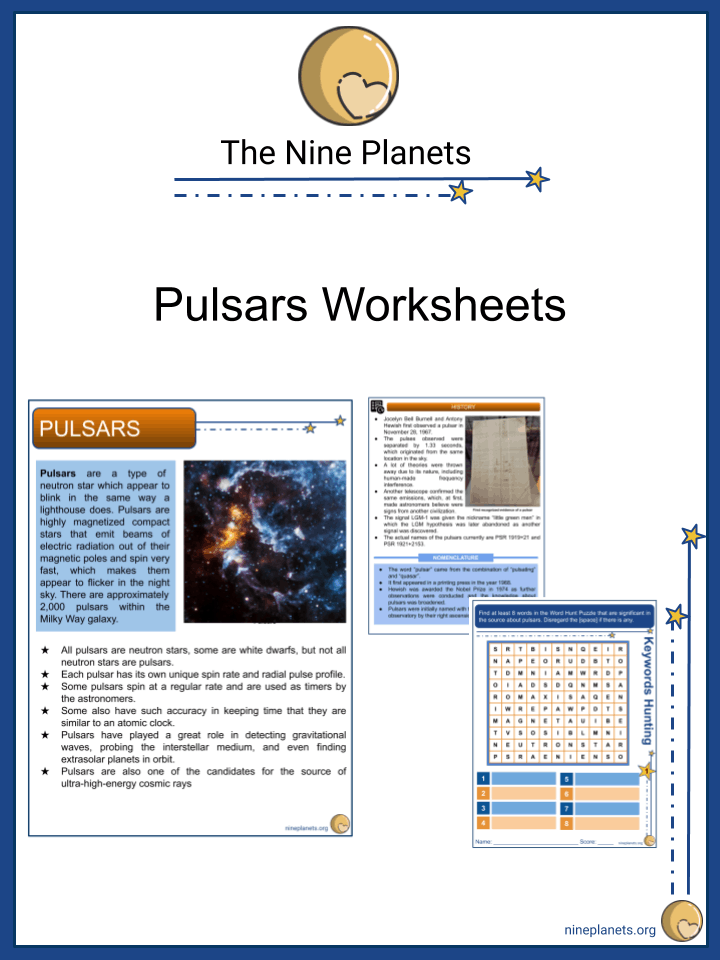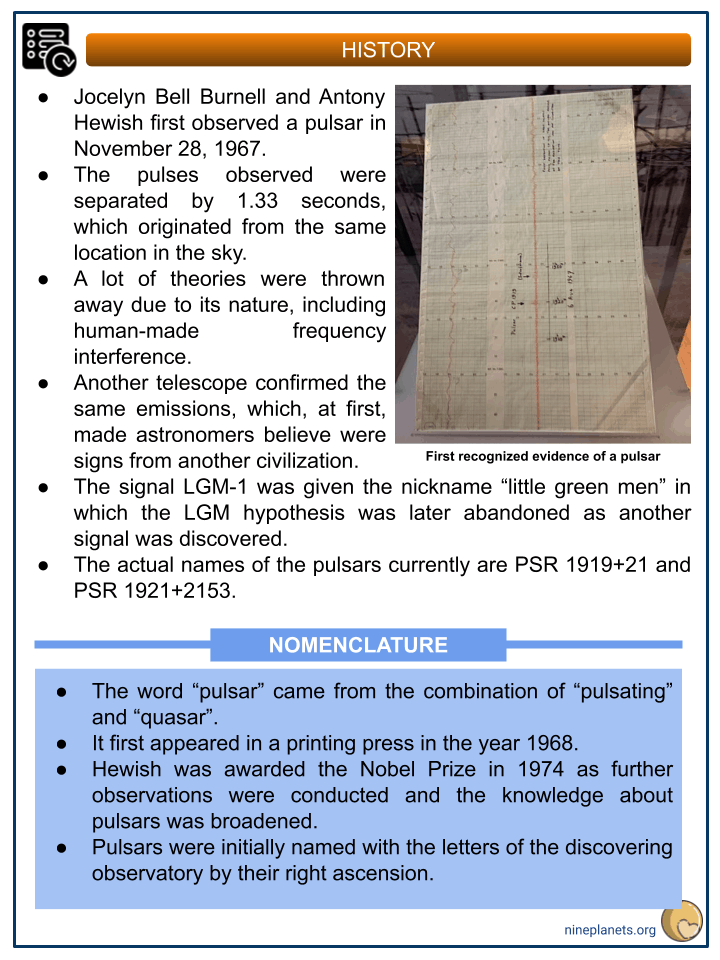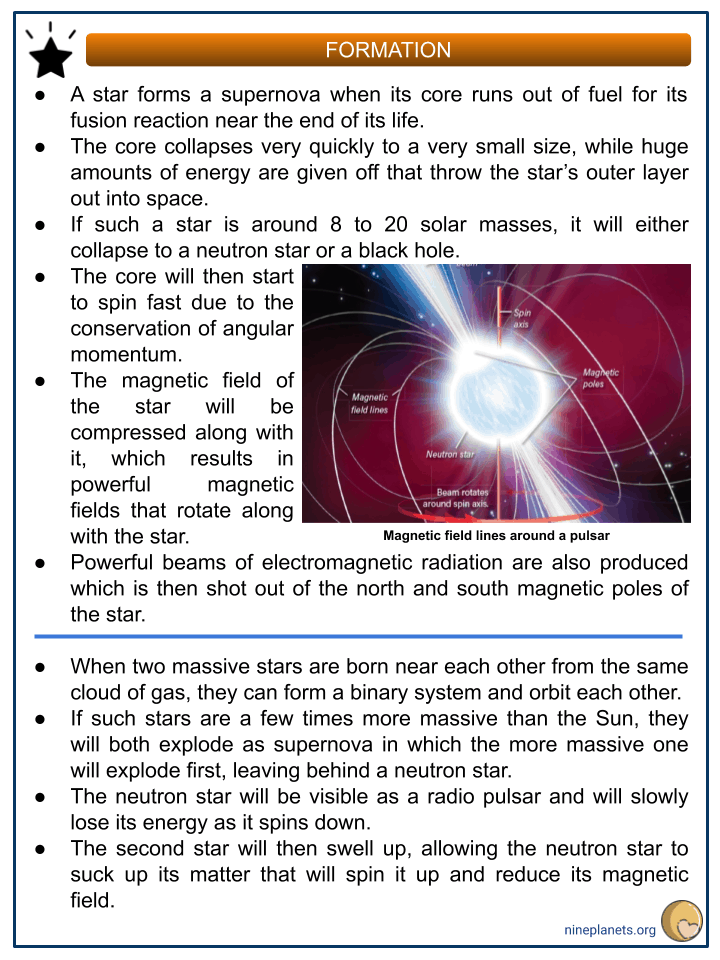Download Pulsars Worksheets
Click the button below to get instant access to these premium worksheets for use in the classroom or at a home.

This worksheet can be edited by Premium members using the free Google Slides online software. Click the Edit button above to get started.
Download free sample
Not ready to purchase a subscription yet? Click here to download a FREE sample of this worksheet pack.
Resource Examples
Click any of the example images below to view a larger version.




Key Facts & Information
- Pulsars are a type of neutron star which appear to blink in the same way a lighthouse does. Pulsars are highly magnetized compact stars that emit beams of electric radiation out of their magnetic poles and spin very fast, which makes them appear to flicker in the night sky. There are approximately 2,000 pulsars within the Milky Way galaxy.
- All pulsars are neutron stars, some are white dwarfs, but not all neutron stars are pulsars.
- Each pulsar has its own unique spin rate and radial pulse profile.
- Some pulsars spin at a regular rate and are used as timers by the astronomers.
- Some also have such accuracy in keeping time that they are similar to an atomic clock.
- Pulsars have played a great role in detecting gravitational waves, probing the interstellar medium, and even finding extrasolar planets in orbit.
- Pulsars are also one of the candidates for the source of ultra-high-energy cosmic rays
History
- Jocelyn Bell Burnell and Antony Hewish first observed a pulsar in November 28, 1967.
- The pulses observed were separated by 1.33 seconds, which originated from the same location in the sky.
- A lot of theories were thrown away due to its nature, including human-made frequency interference.
- Another telescope confirmed the same emissions, which, at first, made astronomers believe were signs from another civilization.
- The signal LGM-1 was given the nickname “little green men” in which the LGM hypothesis was later abandoned as another signal was discovered.
- The actual names of the pulsars currently are PSR 1919+21 and PSR 1921+2153.
Nomenclature
- The word “pulsar” came from the combination of “pulsating” and “quasar”.
- It first appeared in a printing press in the year 1968.
- Hewish was awarded the Nobel Prize in 1974 as further observations were conducted and the knowledge about pulsars was broadened.
- Pulsars were initially named with the letters of the discovering observatory by their right ascension.
Formation
- A star forms a supernova when its core runs out of fuel for its fusion reaction near the end of its life.
- The core collapses very quickly to a very small size, while huge amounts of energy are given off that throw the star’s outer layer out into space.
- If such a star is around 8 to 20 solar masses, it will either collapse to a neutron star or a black hole.
- The core will then start to spin fast due to the conservation of angular momentum.
- The magnetic field of the star will be compressed along with it, which results in powerful magnetic fields that rotate along with the star.
- Powerful beams of electromagnetic radiation are also produced which is then shot out of the north and south magnetic poles of the star.
- When two massive stars are born near each other from the same cloud of gas, they can form a binary system and orbit each other.
- If such stars are a few times more massive than the Sun, they will both explode as supernova in which the more massive one will explode first, leaving behind a neutron star.
- The neutron star will be visible as a radio pulsar and will slowly lose its energy as it spins down.
- The second star will then swell up, allowing the neutron star to suck up its matter that will spin it up and reduce its magnetic field.
- This event is called “recycling” because it returns the neutron star to a quickly spinning state.
- The second star will also eventually explode in a supernova, producing another neutron star.
- If the explosion fails to disrupt the binary, a double neutron star binary is formed.
- Otherwise, the spun-up neutron star left with no companion becomes a “disrupted recycled pulsar” that spins between a few and 50 times per second.
Characteristics
- Generally, the direction of the electric beam is determined by the magnetic axis which is not similar to the rotational axis of the pulsar.
- Pulsars don’t shine like other stars. If the radio beam is not pointed directly towards earth, they are difficult to spot.
- Its rotation will be seen as little bursts of radio waves for short periods of time, if the radio beam is pointed directly towards us, which makes it appear to blink.
- In rotation-powered pulsars, the beam is due to the rotational energy of the neutron star that generates an electrical field from the movement of very strong magnetic fields.
- This results in the acceleration of protons and electrons on the surface, and the creation of an electromagnetic beam from the poles of the magnetic field.
Classification
- Currently, there are three distinct classes of pulsars known to us. They are classified according to the source of power of the electromagnetic radiation.
- Rotation-powered Pulsars – the loss of rotational energy of the star provides power.
- Accretion-powered Pulsars – most X-ray pulsars belong to this category. The gravitational potential energy of accreted matter provides the power. They produce X-rays that are observable from the Earth.
- Magnetars – the decay of an extremely powerful magnetic field provides the power.
- Although all the three classes are neutron stars, their observable behavior and underlying physics are somehow different, but still share connections.
- X-ray pulsars are one of the oldest rotationally-powered pulsars that have already lost most of their power and have only become visible again after their binary companion have expanded and transferred matter on the neutron star.
- This process of accretion can in turn transfer sufficient angular momentum to the neutron star in order to “recycle” it as a rotation-powered millisecond pulsar.
- The neutron star is thought to “bury” the magnetic field as the matter lands on it, leaving millisecond pulsars with a magnetic field 1,000 to 10,000 times weaker than average ones.
- Millisecond pulsars usually live for billions of years, which makes them the oldest known pulsars.
- A lot of such pulsars have been discovered in globular clusters, which have long since stopped their neutron star formation for billions of years.
Significant Pulsars
- Many pulsars have their own unique characteristics, such as their pulse periods often differ from one another.
- CP 1919, now known as PSR B1919+21, is the first known radio pulsar discovered in 1967 with a pulse period of 1.337 seconds and a pulse width of 0.04-second.
- PSR B1913+16 is the first binary star, which has a decaying orbit of an exact rate predicted due to emissions of gravitational radiation by general relativity discovered by Russell Hulse and Joseph Taylor in 1974.
- PSR B1913+16 orbits another neutron star with an orbital period of 8 hours.
- Vela Pulsar is the brightest radio pulsar, which is associated with the Vela Supernova Remnant in the Vela Constellation.
- PSR B1937+21 is the first millisecond pulsar discovered in the Vulpecula Constellation by a team led by Don Backer in 1982.
- PSR J0436-4715 is the brightest and closest millisecond pulsar that emits a searchlight-like radio beam that sweeps past Earth every time it rotates.
- Cen X-3 is the first X-ray pulsar discovered in the Centaurus Constellation.
- SAX J1808.4-3658 is the first accreting millisecond pulsar.
- PSR B1257+12 is the first pulsar with planets namely, “Draugr”, “Poltergeist”, and “Phobetor” discovered by Aleksander Wolszczan in February 9, 1990.
- PSR J0738-4042 is the first pulsar observed to have been affected by asteroids discovered in 1968.
- PSR J0737-3039 is the first double-pulsar binary system discovered by the team led by Marta Burgay in 2003.
- PSR J1748-2446ad is the shortest period pulsar discovered by Jason Hessels in 2004 with a period of ~0.0014 seconds or ~1.4 milliseconds.
- AR Scorpii is the longest period pulsar and the only known white dwarf pulsar with a period of 118.2 seconds, which was once misclassified as a Delta Scuti variable.
- PSR J0250+5854 is the longest period neutron star pulsar at 23.5 seconds.
- PSR J0437-4715 is the pulsar with the most stable period.
- PSR J0250+5854 is the longest period neutron star pulsar at 23.5 seconds.
- mass companions observed in 2007
- PSR J1841-0500 is one of the two pulsars that have stopped pulsing for a longer time, it stopped pulsing for 580 days.
- PSR B1931+24 is the other one that have stopped pulsing for a longer time but it has a cycle. It pulses for about a week and stops pulsing for about a month.
Did You Know?
- We can listen to the pulse profiles of Pulsars. A lot of audio files are available online to fully grasp the intensity of their spinning power.
- A sample link that provides audio files of some pulsars: http://www.astrosurf.com/luxorion/audiofiles-pulsar.htm
- Some pulsars spin very fast with more than 100 times per second that we actually hear a single tone while listening to them.
- Pulsars have a turn-off mechanism. When their spin period slows down sufficiently it turns off which is believed to take place for around 10 to 100 million years.
- If the turn-off hypothesis is true, all or 99% of the neutron stars born in the 13.8 billion year age of the universe no longer pulsate.
- The discovery of pulsars actually led to the discovery of neutron stars.
- The discovery of the first known extrasolar planets around PSR B1257+12 presented important evidence concerning the widespread existence of planets outside the Solar System.
- Millisecond pulsars have allowed a test of general relativity in conditions of an intense gravitational field.
Future
- Pulsars are still closely studied by the scientific community.
- Though few pulsars have been found, they still display many unique characteristics.
- Pulsars have many applications, for instance, their emissions rival the atomic clock, probes of interstellar medium and space-time, and act as gravitational waves detectors.